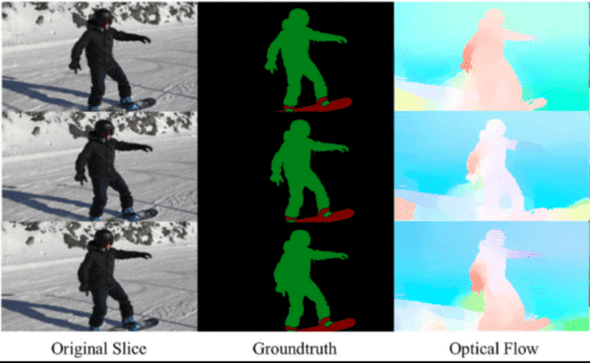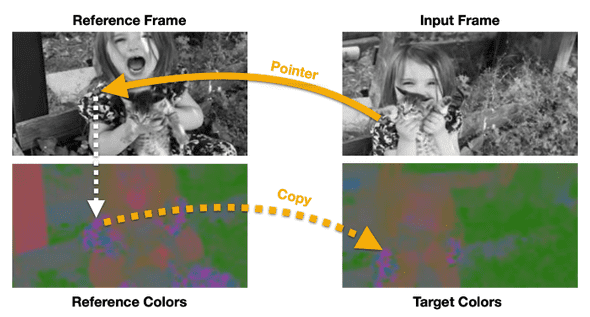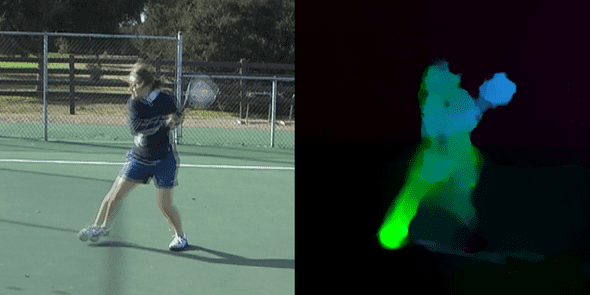Before we get into what self-supervised attention means, let’s get an intuition of optical flow estimation and how it serves as an approach for tracking objects by both humans and computer vision systems.
It is a consensus that object tracking is a fundamental ability that is developed by a human baby at an early age of about two to three months. However, at the level of neurophysiology, the actual working mechanism of the human visual system still remains somewhat obscure. Similar to the human visual system, computer vision systems also widely use tracking for various applications like video surveillance and autonomous driving. The objective of a tracking algorithm is to relocate a particular set of objects in a given video sequence that it has identified in the initial frames. In the research literature related to tracking, it is studied under two major categories namely Visual Object Tracking (VOT) and Semisupervised Video Object Segmentation (Semi-VOS). The first one (VOT) aims to track objects by relocalizing object bounding boxes throughout the video sequence. Whereas the latter (Semi-VOS) tracks objects at a more fine-grained level through a pixel-level segmentation mask. In this blog, we will discuss the original idea behind the latter approach i.e Dense Optical Flow Estimation and how this kind of dense tracking approach is achieved through self-supervised attention mechanisms.
Dense Optical Flow Estimation
Dense optical flow is one of the categories of the concept of Optical flow. Optical flow can be defined as the motion of objects between consecutive frames of a video sequence, as a consequence of relative motion between the object and camera. To explain the same in a scientific language, we can say that optical flow is the distribution of apparent velocities of movement of brightness patterns in an image that arises from the relative motion of objects and the viewer. Optical flow is studied as Sparse optical flow and Dense optical flow. Sparse optical flow derives flow vectors of only a few interesting pixels in the frame that either depict some edge or corner of an object. On the other hand, Dense optical flow derives flow vectors of all the pixels in a given frame, thus giving a higher accuracy at the cost of more computation and less speed.
Dense optical flow computes one optical flow vector per pixel for every frame in the video sequence. Unlike sparse optical flow, this approach gives a more suitable output for applications such as video segmentation and structural learning from motion. Dense optical flow can be implemented by various methods. Among them, one of the simplest to use algorithm is the Farneback method. It is based on Gunner Farneback’s algorithm which is explained in “Two-Frame Motion Estimation Based on Polynomial Expansion” by Gunner Farneback in 2003. OpenCV provides the code function to this algorithm to find the dense optical flow. For a quick experience of what Farneback’s algorithm is, run the following code snippet.
import cv2
import numpy as np
from glob import glob
import requests
import os
def get_video(video_url):
r = requests.get(video_url, stream = True)
with open('./vid.mp4', 'wb') as f:
for chunk in r.iter_content(chunk_size = 1024*1024):
if chunk:
f.write(chunk)
def estimate_optical_flow(video, frame_dir):
ret, frame1 = video.read()
prvs = cv2.cvtColor(frame1,cv2.COLOR_BGR2GRAY)
hsv = np.zeros_like(frame1)
hsv[...,1] = 255
seq = 1
while(1):
ret, frame2 = video.read()
next = cv2.cvtColor(frame2,cv2.COLOR_BGR2GRAY)
flow = cv2.calcOpticalFlowFarneback(prvs,next, None, 0.5, 3, 15, 3, 5, 1.2, 0)
mag, ang = cv2.cartToPolar(flow[...,0], flow[...,1])
hsv[...,0] = ang*180/np.pi/2
hsv[...,2] = cv2.normalize(mag,None,0,255,cv2.NORM_MINMAX)
rgb = cv2.cvtColor(hsv,cv2.COLOR_HSV2BGR)
cv2.imwrite(f"{frame_dir}/{seq}.png",rgb)
seq+=1
if seq==200:
break
video.release()
def generate_output(frame_dir):
img_array = []
for filename in sorted(glob(f"{frame_dir}/*.png")):
img = cv2.imread(filename)
height, width, layers = img.shape
size = (width,height)
img_array.append(img)
fourcc = cv2.VideoWriter_fourcc(*'mp4v')
out = cv2.VideoWriter('./Dense-optical-flow.mp4', fourcc, 20.0, size)
for i in range(len(img_array)):
out.write(img_array[i])
out.release()
def main():
video_url = "https://viratdata.org/video/VIRAT_S_010204_05_000856_000890.mp4"
get_video(video_url)
video = cv2.VideoCapture("./vid.mp4")
if not os.path.exists('./frames'):
os.mkdir('./frames')
estimate_optical_flow(video, './frames')
generate_output('./frames')
if __name__ == "__main__":
main()After running the above code, you will get the following output (right side) in a video(Dense-optical-flow.mp4)

The Farneback algorithm is an effective technique to estimate the motion of certain image features by comparing two consecutive frames from a video sequence. The algorithm first uses the polynomial expansion transform to approximate the windows of image frames through the quadratic polynomials. Polynomial expansion transform is a signal transform designed exclusively in the spatial domain and can be used for signals of any dimensionality. The method observes the translation of the polynomial transforms to estimate displacement fields from polynomial expansion coefficients. This method then computes the dense optical flow after a series of iterative refinements. In the implementation code, the algorithm computes the direction and magnitude of optical flow from a two-channel array of flow vectors (dx/dt, dy/dt). The computed direction and magnitude are then visualized by the value of HSV color representation which is set to a maximum of 255 for optimal visibility.
Deep Learning for Dense Optical Flow Estimation
Historically, the problem of optical flow is an optimization problem. After the recent developments in deep learning, many researchers have applied deep learning to solve this optimization problem by processing consecutive video frames as input to calculate the optical flow of the object in motion. Although these approaches just process two consecutive frames at a time, still the essence of a video is captured in these two frames. The main thing that distinguishes videos from images is that videos possess a temporal structure in addition to the spatial structure of the images. However, videos also have other modalities such as sound, but they are of no use in this case. Therefore consecutive frame stream can be interpreted as a collection of images operating in a specific temporal resolution (fps). This means that data in a video is encoded not only spatially but also sequentially, which makes classifying videos quite interesting and yet challenging at the same time.

Self-Supervised Deep Learning for Tracking
As mentioned earlier, visual tracking is integral for many tasks like recognition, interaction, and geometry under the domain of video analysis. But at the same time using deep learning for these tasks becomes infeasible due to the huge requirement of labeled video data. Anyway, to achieve high performance, large-scale tracking datasets become necessary which in turn requires extensive efforts and thus makes the deep learning approach more impractical and expensive. Keeping this in mind, recent researchers have put their faith in a promising approach to make the machines learn without human supervision (labeled data) by leveraging large amounts of unlabeled and raw video data. This quest for self-supervised learning started with a research proposal from the Google research team that suggested to make a visual tracking system by training a model on a proxy task of video colorization that doesn’t require any additional labeled data (self-supervision). However, the research suggested that instead of making the model predict the color of the input grayscale frame, it must learn to copy the colors from a set of reference frame, thus leading to the rise of a pointing mechanism that is able to track the spatial feature of a video sequence in a temporal setup. Visualizations and experiments of these self-supervised methods suggest that, although the network is trained without any human supervision, a mechanism for visual feature tracking automatically emerges inside the network. After plenty of training on unlabeled video collected from the internet, the self-supervised model was able to track any segmented region specified in the initial frame of the video frame sequence. However, the self-supervised deep learning methods are trained on an assumption that the color in the frame sequence is temporally stable. Clearly, there are exceptions, like colorful lights can turn on and off in the video.


Self-supervised Attention under the Hood
If you look deeper into what actually is the pointer mechanism that is being learned here, you will come to the conclusion that it is a type of attention mechanism. Yes, it’s ultimately the famous trio of QKV (Query-Key-Value, the basis of most attention mechanisms).

Restricted Attention for minimizing physical memory costs
The above-proposed attention mechanism usually comes with high physical memory cost. Therefore processing high-resolution information for correspondence matching can lead to large memory requirements and slower speed.

Conclusion
In this blog, we started with an introduction to the concept of optical flow and studied its application in object tracking. We also studied how this concept inspired the deep learning tracking systems and how self-supervision and visual attention plays a key role in making these systems. The computed optical flow vectors open a myriad of possible applications that require such an in-depth scene understanding of videos. The discussed techniques are majorly applied to pedestrian tracking, autonomous vehicle navigation, and many more novel applications. The variety of applications where the optical flow can be applied is only limited by the ingenuity of its designers. In my personal opinion, self-supervision will soon serve as a strong competitor to its supervised counterpart because of its generalizability and flexibility. Self-supervision easily outperforms most of the supervised methods on unseen object categories, which reflects its importance and power in the coming time as we take our steps towards solving human intelligence. My blogs are a reflection of what I worked on and simply convey my understanding of these topics. My interpretation of deep learning can be different from that of yours, but my interpretation can only be as inerrant as I am.
Read more 📖
🙏 Thanks for reading! hope you liked the post. Have a nice day bye! 👋
Comment down if you want to know more
